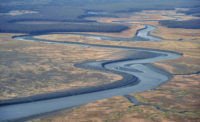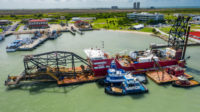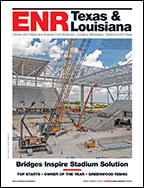While the MARAD assesses availability of vessels and makes recommendations to DHS/Customs, DHS/Customs makes a decision on the waiver based on the availability of suitable vessels.
Shaw has identified enough U.S. equipment to do the job, if it can be brought under contract. Most of the equipment is already in use on Corps projects in south Louisiana, Hess says. “We’re working with the Corps to coordinate releases and anticipate having everything in place in about 30 days,” says Ancil Taylor, president of the Bean Cos.
The Bean Cos. and GCR & Associates Inc.—both New Orleans firms—have been working with the state to plan a coastal barrier-island renourishment project for years. Now that the project has taken on such urgency, both firms have become subcontractors to Shaw.
Hess says getting the right amount of equipment on the job is the goal, because getting too much could actually slow it down. “It’s not as easy as saying, ‘Let’s throw more resources and equipment at it and we can do it twice as fast.’ ”
The area is shallow and has “limiting geography,” Hess says. Cutterheads work from an anchored position, moving within a defined area. Hoppers work by cutting into material, moving along a line, turning around and coming back again, Hess explains. “So you can’t have lots of hoppers in close proximity,” he says.
A big cutter dredge in operation requires a fleet of support vessels, Taylor adds. “It may incorporate between 20 to 30 other vessels and barges. If you’ve got five to seven dredges working in a relatively small area, you’ve got 130 to 150 vessels out there.”
Taylor says the California is 640 ft long and works with 29 associated vessels.
While the armada is being assembled, Shaw is performing bathymetric surveys of topographic conditions, inventorying birds and other wildlife, and conducting magnetometer surveys and sonar scans to pinpoint underlying historically significant structures and pipelines.
“What we are doing is purely unprecedented,” Taylor says.
“Shaw and GCR are bringing the information in real time and providing us details to create setups or buffer zones to avoid relics, pipes and [other] things when we’re dredging. Normally, this process would take years, and we’re doing this as dredges are sailing to the site. Shaw and GCR have done an unbelievable job of processing this information in real time,” Taylor says.
The state wants the work performed in 90 days, but Shaw’s estimates indicate the most realistic schedule is about 140 days, Hess says. That timeframe will extend further as the contractor goes back and forth with the Corps and state to make sure it is in compliance with the special conditions of the emergency permit.
“I’m trying to look at the equipment spread we have [and the] anticipated production of equipment, make assumptions about suitable material, meet the necessary requirements and be as cost-effective as possible,” Hess says.





Post a comment to this article
Report Abusive Comment